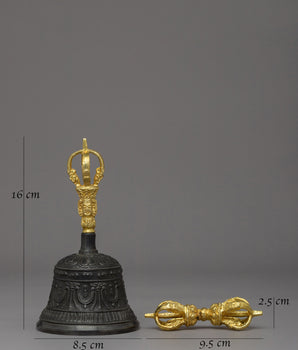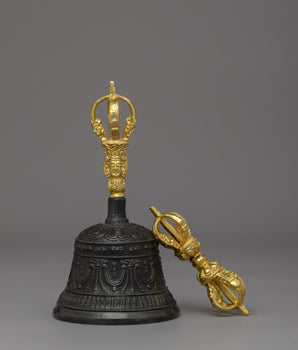The Enigmatic Presence: Lord Krishna's Role in Buddhism
Lord Krishna, a revered figure in Hinduism, has profoundly shaped India's cultural and spiritual landscape. Let us delve into the historical and philosophical links between Krishna Lord and Buddhism, examining how his teachings and legends transcend the boundaries of these spiritual traditions.
Key Takeaways
- Lord Krishna is in Buddhist texts and iconography, demonstrating a historical connection.
- His appearance in Jataka tales illustrates his moral and ethical significance.
- He shares attributes with Avalokiteshvara, reflecting a syncretic influence between traditions.
- His teachings and the concept of bhakti have impacted Bhakti Buddhism in India and beyond.
Lord Krishna In Buddhism

Click here to view our Sri Krishna Statue
The convergence of religious traditions often leads to fascinating intersections of beliefs, myths, and iconic figures. A notable intersection unfolds between Hinduism and Buddhism, where Sri Krishna, a central deity in Hinduism, becomes a significant presence in Buddhism's historical and philosophical realms. This article embarks on a journey to unveil the multifaceted role of Krishna within Buddhism, exploring both historical references and philosophical intersections.
Historical Context of Buddhism and Hinduism To grasp the connection between the deity and Buddhism, it is crucial to acknowledge the historical coexistence of these religions. Buddhism and Hinduism share ancient roots in the Indian subcontinent, evolving alongside each other for centuries. Despite their distinct theological principles, their mutual influence is profound. Within this dynamic context, we witness the interplay of Krishna's presence in Buddhist narratives.
Shri Lord Krishna in Buddhist Texts
Jataka Tales: A compelling instance of the deity'd integration into Buddhism is evident in the Jataka tales. These stories recount the past lives of Siddhartha Gautama, the historical Buddha, in various incarnations. In certain tales, he emerges as a virtuous and compassionate figure.
Vessantara Jataka: In the "Vessantara Jataka," Krishna Lord takes the form of King Sivi, who willingly sacrifices his flesh to rescue a dove from a hawk. This narrative underscores themes of selflessness, compassion, and the virtues of a righteous ruler. Although distinctly Buddhist, the presence of Krishna as King Sivi highlights his moral and ethical significance within the Buddhist context.
Incorporation into Buddhist Art: Krishna and Buddhism
Krishna God's image has also been incorporated into Buddhist art. Lord Krishna is depicted alongside Buddhist figures in specific Buddhist sculptures and paintings, emphasizing his influence on the region's artistic heritage. These artistic representations often showcase his divine qualities and role as a virtuous conduct symbol.
Krishna Lord's ethical teachings resonate with Buddhist thought. His emphasis on dharma (righteous duty), karma (action and its consequences), and the path to spiritual liberation align closely with fundamental Buddhist principles.
As articulated in the Bhagavad Gita, Krishna's teachings provide profound insights into the nature of existence, the pursuit of righteousness, and the realization of one's true self. These themes share common ground with Buddhist concepts of impermanence, karma, and the quest for enlightenment. While the Bhagavad Gita is a cornerstone of Hindu philosophy, its ethical and philosophical content has reverberated in the minds of Buddhist scholars and practitioners.
Lord Krishna & Radha: An Eternal Saga of Divine Love

Click here to view our Krishna and Radha Statue
The love story of Lord Krishna and Radha stands as a profound narrative within Hindu mythology, symbolizing an enduring love that transcends both material and spiritual realms. Rooted deeply in India's cultural and spiritual fabric, this tale provides profound insights into divine love, devotion, and the cosmic dance between masculine and feminine principles.
This tale finds its roots in ancient texts like the Bhagavata Purana and poetic works such as Jayadeva's Gita Govinda. These narratives unfold Krishna's divine play (Leela) in Vrindavan, portraying his youthful adventures and profound spiritual affection for Radha.
Radha: The Embodiment of Devotion
Radha is often considered the epitome of supreme devotion (Bhakti) and unconditional love towards Krishna. Her love for Krishna is not bound by worldly ties but is seen as the soul's pure, unwavering devotion to the divine.
Krishna: The Divine Beloved
Krishna, conversely, epitomizes the divine beloved, serving as the ultimate object of love and devotion. His interactions with Radha and the Gopis of Vrindavan exemplify how the holy draws the individual soul closer, offering both joy and spiritual liberation.
The Krishna-Radha love story transcends mere earthly romance, serving as a metaphor for the soul's quest for reunion with the divine. Krishna, an incarnation of Lord Vishnu, symbolizes the universal self or God, while Radha embodies the individual soul (Atma), yearning for connection with the supreme soul (Paramatma).
The Krishna Lord-Avalokiteshvara Connection
The syncretism between Hinduism and Buddhism is further exemplified by the connection between Krishna and Avalokiteshvara, one of the most revered bodhisattvas in Mahayana Buddhism. Avalokiteshvara is often depicted with multiple arms, each bearing symbols of compassion and wisdom. Intriguingly, Avalokiteshvara's appearance bears a resemblance to the iconic imagery of Krishna.
The concept of compassion embodied by Avalokiteshvara mirrors Krishna's divine love and compassion in Hinduism. This syncretic influence suggests a harmonious blending of spiritual attributes, reflecting the interconnectedness of Indian religious traditions.
Krishna's Influence on Bhakti Buddhism
Bhakti, the path of holy love and surrender to a divine figure, has been a central theme in Hinduism and Buddhism. Lord Krishna's teachings and the concept of bhakti have left a lasting imprint on Bhakti Buddhism. This movement emphasizes devotion to the Buddha and bodhisattvas to attain enlightenment.
In Bhakti Buddhism, adherents express their love and devotion to the Buddha and other enlightened beings, seeking their guidance and blessings. Lord Krishna's role as a divine figure of faith has found resonance among Bhakti Buddhists, who view him as a source of inspiration for their devotional practices.
While Bhakti Buddhism and Hinduism have unique deities and figures, the historical and cultural interactions between these traditions in the Indian subcontinent occasionally result in instances where the deity's imagery appears in Buddhist-influenced art. It's important to note that such depictions are relatively rare and typically symbolic rather than fully encapsulating his theological significance in Hinduism.
Lord Krishna's Iconography and Symbolism
- Skin Color: Lord Krishna is commonly depicted with dark blue or black skin, symbolizing his divine nature and association with the color of the night, representing transcendence.
- Clothing: He is often portrayed in a yellow dhoti (loincloth) and a peacock feather crown, reflecting his simple pastoral lifestyle as a young cowherd.
- Ornaments: Adorned with necklaces, bracelets, anklets, and earrings, Krishna's ornaments symbolize his divine status and regal presence.
- Crown: His crown, typically adorned with a peacock feather, signifies his connection with nature and reflects his playful nature as a child.
Physical Attributes:
- Flute: Nearly always depicted with a flute, symbolizing divine music and enchanting melodies that captivate devotees' hearts. It represents the harmony of the soul and a call to spiritual awakening.
- Peacock Feather: In his crown, the peacock feather symbolizes his connection with nature and victory over the serpent demon, Kaliya.
- Cow: In some representations, the deity is seen playing with cows or with a cow by his side, signifying their sacredness in Hinduism and representing purity, abundance, and protection.
Iconography and Symbolism:
- Bala Krishna: In his childhood form as "Bala Krishna," he depicted crawling, stealing butter, or playing pranks, representing the divine playfulness and innocence of the deity.
- Krishna as a Divine Lover: In adolescent and adult forms, he is portrayed as a charismatic and divine lover, symbolizing profound love between the individual soul (jiva) and the divine (Paramatma).
- Vishvarupa: In the Bhagavad Gita, he reveals his universal form (Vishvarupa) to Arjuna, displaying his cosmic and omnipotent nature. This form includes various divine manifestations, symbolizing the all-encompassing reality.
The presence of Krishna in Buddhism goes beyond mere historical curiosity; it epitomizes the intricate interplay of spiritual traditions in the Indian subcontinent. His occurrences in Buddhist texts influence ethical teachings, and his connection with bodhisattvas like Avalokiteshvara underscores the permeable boundaries between Hinduism and Buddhism.
As Buddhism and Hinduism coexisted and mutually influenced each other over centuries, the discovery of shared themes, figures, and ideas is unsurprising. Lord Sri Krishna's integration into Buddhism is a testament to the dynamic nature of religious traditions, showcasing their capacity to inspire and enrich one another. Ultimately, the enduring legacy of Krishna in Buddhism serves as a poignant reminder of the transcendent power of spiritual figures to surpass the confines of their original traditions, perpetually inspiring seekers on their spiritual journeys.










